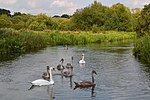Longparish
Hampshire geography stubsTest ValleyVillages in Hampshire

Longparish is a village and civil parish in Hampshire, England. It is composed of the four hamlets of Middleton, East Aston, West Aston and Forton that over time have expanded and effectively joined up to become one village. Longparish is situated on the northwest bank of the River Test. In 2011 the population (including Firgo and Forton) was 716.
Excerpt from the Wikipedia article Longparish (License: CC BY-SA 3.0, Authors, Images).Longparish
Longparish Road, Test Valley
Geographical coordinates (GPS) Address Nearby Places Show on map
Geographical coordinates (GPS)
| Latitude | Longitude |
|---|---|
| N 51.201 ° | E -1.3788 ° |
Address
Longparish Road
Longparish Road
SP11 6QQ Test Valley
England, United Kingdom
Open on Google Maps








